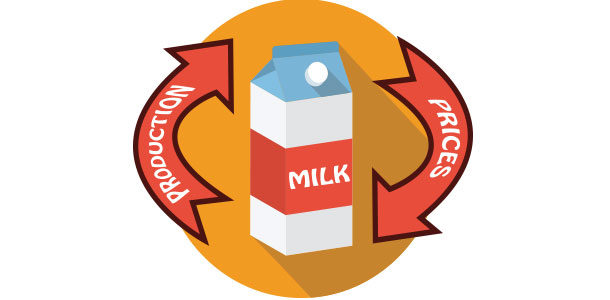According to the Rabobank Dairy Quarterly report of June 2015, there’s still more milk than market, and it may be later rather than sooner before that changes.
“While we are well off the record level achieved in late 2014, producer milk prices in the U.S. are still 15 percent and 57 percent higher than those presently being paid to dairy farmers in the Netherlands and New Zealand,” said Rabobank Global Dairy Strategist and report lead author Tim Hunt in a statement.
That being said, U.S. milk prices have fallen considerably in the last eight months. And any kind of premium enjoyed by U.S. farmers will be hard to come by as the international milk market continues to see surplus milk levels.
China slashed imports during 2015’s first quarter, and Russia remained closed to imports. Other buyers feverishly purchased with anecdotal reports saying much of the buying was for inventory, and buying has since slowed.
During quarter one, after falling marginally, crucial export markets like the E.U., New Zealand, Argentina and Uruguay returned to year-over-year growth, thus ending the most short-lived surplus contraction in these regions in a decade and also enabling producers to capitalize on what remained of profitable quarter-one prices.
The report states if there was a price bubble in the first quarter of 2015, it burst in quarter two. Key dairy commodities dropped 20 percent to 30 percent, reaching levels comparable to 2009. In regions like New Zealand and the E.U., falling commodity markets have pushed milk prices at or below breakeven.
To date, the U.S. dairy market has weathered the storm much better than international neighbors.
Wholesale pricing for non-fat dry milk and whey traded in line with much of the international market for quarter two. But happily, U.S. cheese and butter prices resisted the downward slump.
The two products actually rose and remained at a premium to international prices thanks to strong domestic demand, import barriers and the CWT program.
These premiums helped shield U.S. producers through quarter two from the international slump of commodity prices. May’s U.S. all-milk price of $16.50 per hundredweight was 57 percent higher than Fonterra’s New Zealand 2014-2015 season milk price and 18 percent higher than FrieslandCampina’s milk price.
Dominant milk prices, low feed costs and excellent cull cow prices worked to keep average U.S. producer milk income over feed cost above the breakeven $8 per hundredweight in quarter two.
“The U.S. dairy market actually grew faster than those of most of the BRIC economies in quarter one,” Hunt said. “Employment growth, higher wages and lower gas prices helped boost U.S. cheese sales by 4.5 percent in quarter one in year-over-year terms. Butter sales are also well up while the contraction in fluid milk slowed.”
U.S. production growth reached 1.6 percent year-over-year in the first four months of 2015. Broad-based growth, in states aside from California, has helped offset the contraction coming from California’s drought-depressed state.
The report warns, however, the second half of 2015 may be challenging for U.S. dairy producers.
Rabobank expects the international market to remain oversupplied through the coming six months as supply growth continues to outstrip demand, as China continues to rebalance and buyers end their recent stock build programs.
In this environment, sustaining the current premium for the U.S. domestic market through the second half of 2015 is likely to prove an impossible task, according to Rabobank.
Higher prices in the U.S. are encouraging greater production growth than what is being seen in most regions throughout the world, said Hunt. He added that suppliers are exporting less, down 10 percent, and directing more products to the more profitable domestic market.
Imports are coming in as fast as trade barriers will allow, up 20 percent – a situation likely to increase local supply faster than the domestic market can sustain. The report cites the USDA’s April Cold Storage numbers showing butter and cheese inventories up 24 percent and 4.2 percent respectively year-over-year.
“We expect butter and cheese prices to come in considerably below the current levels suggested by the CME forward curve in quarters three and four, as the international milk glut feeds its way into the U.S. market,” Hunt said. “Class III milk could easily be priced at or below $15 per hundredweight by quarter four, driving the income over feed costs below $7 per hundredweight for the average U.S. farmer.”
Such tight prices mean a slowing of U.S. year-over-year production growth, currently forecasted at 0.7 percent. Meaning exportable surplus will contract somewhat in the second half of 2015 in year-over-year terms, states the report, as domestic demand will outstrip the production growth rate – a trend Rabobank expects to continue into the first half of 2016, causing another contraction in exportable surpluses.
“At a global level, we still have more milk than market right now,” Hunt said, “and unfortunately U.S. producers are unlikely to get through the next six months as easily as current futures pricing suggests.”
According to the report, better domestic demand, a strong U.S. dollar and gaining E.U. supply will push the U.S. to reduce exports throughout the next 12 months – temporarily, at least, stalling a four-year trend of increasing surpluses.
By late 2015, early 2016 prices are expected to enter a recovery phase thanks to a period of slow production growth and the stabilization of Chinese imports, improved consumer demand and an ongoing rise in income. PD
Paige S. Nelson resides in Rigby, Idaho, and is an agricultural freelance writer.





